 |
 |
|
Home
Next Section
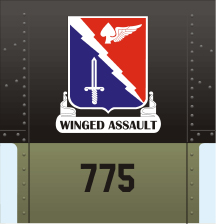
Captain Freeman's nose art
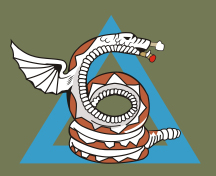
"Ancient Serpent 6" door logo on Major Crandall's Huey
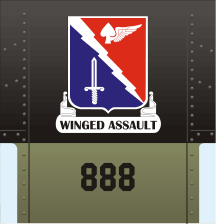
Major Crandall's nose art
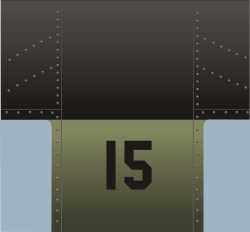
Nose art of UH-1E Huey flown by Captain
Pless
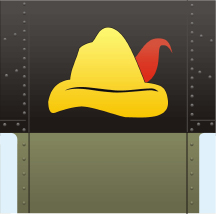
Nose art of 173rd AHC "Robin Hood" Lift
Platoon
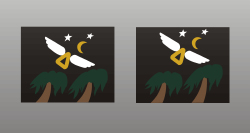
Night Rescue Mission talleys painted on
the right side of Lt Lassen's aircraft, just below the pilot's door. There
were two mission talleys on the ship.
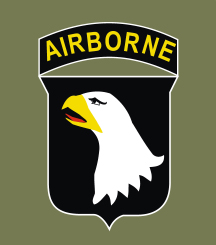
Tail insignia of B Troop, 2nd Squadron,
17th Cavalry
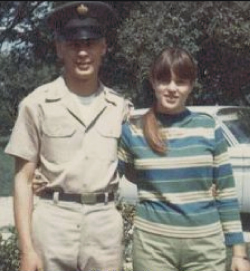
Joseph "Guy" LaPointe and his wife Cindy
shortly before Guy shipped out to Vietnam. (photo courtesy of Cindy
LaPointe Dafler)
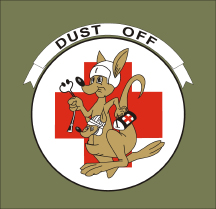
Door insignia of the 82nd Medical
Detachment

Nose and cargo door insignia of 82nd
Medical Detachment |
|
|
|
|
|
|
|
|
|
|
|
|
|
|
|
|
|
|
|
|
|
| |
|
 |
|
Captain Ed Freeman
- November 14, 1965
A Company, 229th
Aviation Battalion |
|
|
|
|
|
|
|
|
|
|
|
|
|
|
|
|
|
|
|
|
|
|
|
|
|
|
|
|
|
|
|
|
|
|
|
|
|
|
|
|
| |
|
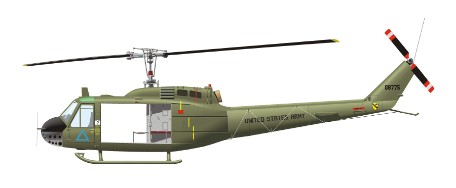 |
|
Click on illustration to
see larger image, then click "back arrow" to return to this page |
|
|
|
|
|
|
|
|
|
|
|
|
|
|
|
|
|
|
|
|
| |
Captain Ed Freeman served as Second-in-command of A
Company, 229th Aviation Battalion in 1965-66. On November 14, 1965, he
flew in support of LTC Hal Moore and the 1/7th Cavalry fighting against
three battalions of NVA at LZ X-Ray in the Ia Drang Valley. Captain Freeman
flew 14 missions into the face of enemy fire over the course of the first
day to deliver much needed ammo and water, and to evacuate wounded soldiers.
He was eventually awarded the Medal of Honor for his actions at LZ X-Ray on
July 16, 2001. Captain Freeman's Huey
displayed the 229th crest on the nose, the A Company blue triangle on the pilots'
doors, and a small 1st Cavalry Division emblem on the rear of the tail boom.
The 229th's aircraft had "high visibility" markings (yellow and
red vertical stripes on the fuselage) at LZ X-Ray. A photo of Captain
Freeman's aircraft taken at LZ X-Ray by Joe Galloway shows that there was no
M60 gun mount, nor a free-hanging M60 being used on his ship. The cargo bay
doors were removed from the aircraft. His ship also sported an antenna
strung along the tailboom. There was a small white or yellow placard on the
frame post just behind the pilot's door with the number "2" in black. This
signified the "second " ship in the combat assault
mission. The canvas seat coverings in early Hueys were red in color. Mr.
Freeman doesn't remember the a/c number of the ship he flew on the first
morning of the battle. Andy Spencer has researched a/c numbers
of early 229th Hueys. In 1965 A Company flew 1963 and 1964 manufactured Hueys with a/c numbers that fell in the ranges of 63-08xxx and
64-13xxx. The majority of A Troop's Hueys were built in 1963. Because Ed Freeman flew a Huey with the nose number of "775" on occasion,
I've illustrated his ship as 63-08775.
|
|
|
|
|
|
|
|
|
|
|
|
|
|
|
|
|
|
|
|
|
| |
|
 |
|
Major Bruce Crandall
- November 14, 1965
A Troop, 229th Aviation
Battalion |
|
|
|
|
|
|
|
|
|
|
|
|
|
|
|
|
|
|
|
|
|
|
|
|
|
|
|
| |
|
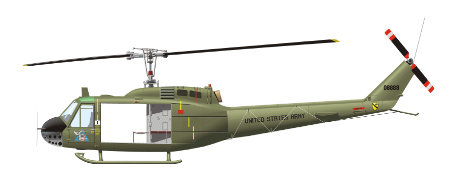 |
|
|
|
|
|
|
|
|
|
|
|
|
|
|
|
|
|
|
|
|
|
|
|
|
| |
Major Bruce Crandall was commander of A Company, 229th Aviation
Battalion, on November 14, 1965 at LZ X-Ray. With Captain Freeman's ship following
him, Major Crandall
flew 14 mission into the hot LZ , taking intense enemy
fire to deliver supplies and evacuate wounded from the battle. As his ship
was damaged by enemy fire (his crew chief was also wounded on one flight),
Major Crandall was forced to switch to another aircraft. He flew a total of three
different ships in his effort to support the troops at LZ X-Ray. Major
Crandall was finally awarded the Medal of Honor on February 26, 2007.
Major Crandall's aircraft was very similar in
appearance to Ed Freeman's, with one major exception. Major Crandall had a unique
A Troop door insignia - a large, winged rattlesnake coiled inside the A
Company triangle symbol. The snake is smoking a lit cigar, and blowing smoke
out it's nostrils. Mr. Crandall told me that flight crews didn't have
assigned aircraft in the 229th. Instead, they took any aircraft that was
available for the mission at hand. As a result, at the end of a mission,
Major Crandall's crew chief would unhinge Major Crandall's distinctive doors
from the aircraft they had just flown. At the beginning of the next mission,
his crew chief would fasten the doors in place on the new aircraft they were
going to fly! That way, Major Crandall's distinctive doors always marked him
out for the other pilots during the mission. Photos also show Major
Crandall's ship displaying a small white or yellow sign with the numeral "1" on
the frame post just behind the pilots' doors. This signified the lead
ship in the combat assault mission. Major Crandall's ship may or may not
have had his rear cargo door present. He did not have an M60 hard mount or
any free-swinging M60 in use during LZ X-Ray. I don't have any photo
evidence that his ship
carried the tail boom antenna, but other 229th Hueys during this time period
did, so I illustrated Mr. Crandall's aircraft with this detail. Mr. Crandall doesn't
remember what a/c number his ship had on the morning of November 14th,
1965. Based on Andy Spencer's research of early 229th a/c numbers, and based
on photos show Bruce Crandall flying ship number "888" on occasion,
I illustrated his aircraft as a/c number 63-08888. |
|
|
| |
|
|
|
|
|
|
|
|
|
|
|
|
|
|
|
|
|
|
|
|
 |
|
|
|
|
|
|
|
|
|
|
|
|
|
|
|
| |
|
|
Captain
Stephen Pless, USMC - August 19, 1967
VMO-6 |
|
|
|
|
|
|
|
|
|
|
|
|
|
|
|
|
|
|
|
|
|
|
|
|
|
|
|
|
|
|
|
|
|
|
|
|
|
|
|
| |
|
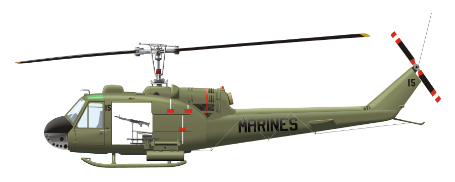 |
|
|
|
|
|
|
|
|
|
|
|
|
|
|
|
|
|
|
|
|
|
|
|
|
|
| |
On the afternoon of
August 19, 1967, Captain Steve Pless and his crew were flying
medevac escort near Quang Ngai (south of Chu Lai in I Corps). On the
way to a pick-up of wounded ROK Marines, they heard an emergency
call on the "Guard" channel from a transport helicopter. It
had set down to make repairs on the beach, and was attacked by a
large number of VC. Four Americans had been left on the ground when
the ship took off, and they were being overrun by the enemy.
Determining that the H-34 they were escorting could make the initial medevac pick-up without their support, Pless and his crew decided to
respond to the emergency call. As they approached the site they
could see the enemy beating and hacking at the four American
prisoners. Pless took his gunship into a gun and rocket run,
targeting a large group of VC in the clearing. Driving the enemy off
with his gun run, Pless landed between the Americans and the enemy.
Gunnery Sergeant Poulson jumped out and ran to support the single
American still capable of walking. Putting the American on board the
aircraft, Poulson, followed by the copilot and other crewman raced
to help the other Americans. Determining one of the Americans to be
dead, the three crewman began carrying the two injured Americans
toward their Huey. At this point the VC attacked and tried to
overrun the crew and helicopter. Pulling out their side arms, the
crew alternately dragged the injured Americans and fired at oncoming
VC. Some of the enemy came within a few feet of their Huey while
they were loading the injured aboard. When all were aboard, Pless
applied power to his grossly overloaded Huey and took off over the
water. The skids of the ship touched the water four times before he
finally got the aircraft to gain altitude. Pless jetisoned his
rocket pods and ordered the crew to throw out all unnecessary items
from the cabin. They landed the injured at Chu Lai First
hospital and returned to their base at Ky Ha. The next day Pless and
his crew learned that 20 VC dead had been found on the beach with
evidence of many more enemy casualties being dragged off. Captain
Pless was promoted to Major in September, 1967, and was awarded the
Medal of Honor on January 19, 1969. The rest of his crew, Captain
Rupert Fairfield, GySgt Leroy Poulson and LCpl John Phelps were all
awarded the Navy Cross. Major Pless was
killed in a motorcycle accident just a few months later on July 20,
1969. He is buried at Barrancas National Cemetery at NAS Pensacola,
FL.
Pless's ship was a UH-1E. The vertical VHS
antenna fin normally mounted on the roof is missing. This was common
on Marine UH-1E's. However, there was a large rounded dome on the
roof in front of the engine. To the right of this dome was a
roof-mounted hoist (not visible in this illustration). Pless's Huey
was a gunship, and had rockets and dual M60s mounted on a Marine
TK-2 weapons mount system. There were also defensive M60s mounted on
swivels for the crew. The MARINE legend on the tail boom was painted
in flat black. The aircraft number "15" was painted on the nose,
behind the pilot's doors, and on the tail in flat black. Step covers
on the aft cabin sides were painted red. There were vertical white
stripes around the covers, and a vertical red stripe on the engine
cowling. Like most Marine UH-1Es, this Huey carried tail boom
mounted antennas. This Huey survived the
Vietnam War and in 2005 was restored to it's August 1967 appearance
by the National Museum of the Marine Corps in Quantico, VA. The Huey
is now on display in their Vietnam gallery. |
|
|
| |
|
|
|
|
|
|
|
|
|
|
|
|
|
|
|
|
|
|
| |
|
 |
|
PFC Gary Wetzel -
January 8, 1968
173rd AHC |
|
|
|
|
|
|
|
|
|
|
|
|
|
|
|
|
|
|
|
|
|
|
|
|
|
| |
|
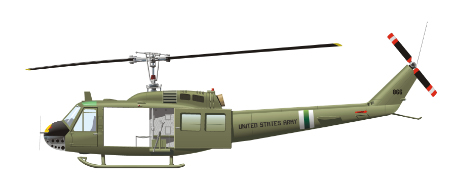 |
|
|
|
|
|
|
|
|
|
|
|
|
|
|
|
|
|
|
|
|
|
|
|
|
| |
PFC (later Sp4c) Gary Wetzel was a door
gunner on "Robin Hood 866" in January, 1968. He was nearing the end
of his second tour when his helicopter was hit by an enemy RPG rocket while
landing in a hot LZ with an insertion team. The grounded helicopter was hit
repeatedly by enemy fire and the pilot, Bill Dismukes, was wounded. As PFC
Wetzel went to the assistance of his pilot, another enemy rocket impacted
the ship just behind the pilot's seat. Wetzel was blown out of the
helicopter, suffering severe wounds to his right arm, chest and legs, and
his left arm was almost severed from his body - hanging only by a flap of
skin. In spite of his multiple wounds, Wetzel climbed back into the damaged
ship and took an enemy automatic weapon position under fire with his door
gun. The enemy gun had the American troops pinned and Wetzel was able to
destroy it with his fire. Wetzel then tried to go to the aid of his pilot
again, but passed out from loss of blood. When he regained consciousness,
his crew chief was dragging the wounded pilot to the shelter of a nearby
dike. Wetzel crawled over and attempted to help the crew chief move the
pilot to safety, but passed out a second time. After he and the other
survivors were rescued, Wetzel's left arm was amputated and he spent five
months in military hospitals recovering from his injuries and infections.
Gary Wetzel was awarded the Medal of Honor on November 19, 1968.
"Robin Hood 866" was a UH-1D. It had the
173rd "Robin Hood" nose art, and 11th Combat Aviation Battalion tail boom
vertical stripes (white-green-white for the 173rd). At this point I don't
know if the tail number was only the three-digit "866" or a five-digit
number. (anyone out there know how the 173rd displayed their tail numbers? -
If so, please contact me!) "866" flew with rear cargo doors during this
action. You can see a photo of heavily damaged "866" after it's
recovery
on page 20 of Wayne Mutza's book "UH-1Huey in Action", published by
Squadron/Signal Publications. |
|
| |
|
|
|
|
|
|
|
|
|
|
|
|
|
|
|
|
|
|
| |
|
 |
|
Lt (jg)
Clyde Lassen, USN June 19,1968
Helicopter Combat Support Squadron
(HC)-7 |
|
|
|
|
|
|
|
|
|
|
|
|
|
|
|
|
|
|
|
|
|
|
|
|
|
| |
|
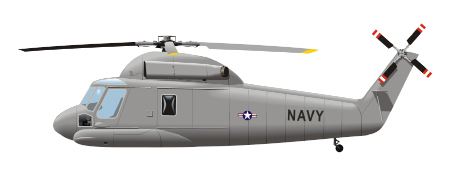 |
|
|
|
|
|
|
|
|
|
|
|
|
|
|
|
|
|
|
|
|
|
|
|
|
|
|
| |
Lt Lassen flew from
the USS Preble (DLG-15), a Guided Missile Destroyer. The
Preble served as a rescue ship for aircraft carriers operating
at Yankee Station in the Tonkin Gulf off the coast of North Vietnam.
In the early hours of June 19,1968, Lt Lassen and his crew were
tasked with attempting the rescue of the crew of an F-4J that had been
shot down south of Hanoi. The pilot and RIO were on the ground in
North Vietnam and so far had evaded enemy patrols. Although his
UH-2A Seasprite was not designed for long-range missions, Lt Lassen
and his crew
were chosen to make the rescue attempt. They took off shortly after midnight, and after holding briefly at the coastline, they
were directed inland toward the downed airmen by the RESCAP aircraft
flying cover over the downed F-4 crew. As Lassen's ship neared their
position, the RESCAP aircraft launched parachute flares to
illuminate the ground. The downed aircrew were in heavy canopy
jungle on a ridge, and their emergency strobe lights couldn't be
seen through the thick canopy. Making radio contact with the men on
the ground, Lassen began a slow descent in a small gap between two
trees, hoping to make a hoist extract. However, the last
illuminating parachute flare went out during his descent, and Lassen
lost all visual references. He hit one of the trees, and the door
next to him was ripped off the ship. The aircraft
sustained other minor damage, but incredibly Lassen was able to
maintain control and climb out of the trees. Lassen then directed
the downed men to make their way to a larger clearing at the bottom
of the ridge. As the men cleared the jungle, Lassen turned on his
aircraft's landing lights and descended to a low hover. The RIO had
a broken leg, and it took two minutes for the two men to make it to Lassen's ship. Heavy enemy fire erupted from the treeline, and
Lassen's door gunners returned fire with their M60's. Once the men
were finally inside, Lassen took off for the coast. He had a
vibrating engine, a broken compass, and a rapidly decreasing fuel
supply. Once he cleared the coast, Lassen headed for the nearest US
ship capable of landing a helicopter. He landed on the USS Jouett
(DLG-29) with 135 lbs of fuel left (5 minutes of flight time!).
Lt Lassen was awarded the Medal of Honor on January 16, 1969 (the
rest of his crew were awarded the Navy Cross).
Clyde Lassen retired from the Navy as a commander in 1982. He
died in April 1994 after a battle with cancer and is buried at
Barrancas National Cemetery at NAS Pensacola, FL.
Lt Lassen's UH-2A Seasprite was painted a flat
gray color, with the legend "NAVY" in flat black on the tail boom.
There was a small color national emblem in front of the Navy legend.
The only other known markings were two "Night Rescue Mission"
talleys painted below the right-side pilot's door (see illustration
at left). Markings on the aircraft were minimal in an effort to
lower visibility during combat SAR (Search and Rescue)operations.
The tops of the main rotor blades appear to have been a light grey
color with yellow tips. The undersides were painted black. The rear
rotors were flat black with red-white-red stripes at the tips. While
the UH-2A Seasprite isn't a "Huey" in the accepted sense - a Bell
manufactured UH-1 series or Cobra, the Kaman Aerospace Industries
UH-2A was part of the UH family of light utility helicopters used
in Vietnam. |
|
|
| |
|
|
|
|
|
|
|
|
|
|
|
|
|
|
|
|
|
|
| |
|
 |
|
Sp4 Joseph G.
LaPointe - June 2, 1969
HQ Troop, 17th Cavalry, 101st Airborne Division |
|
|
|
|
|
|
|
|
|
|
|
|
|
|
|
|
|
|
|
|
|
|
|
| |
|
|
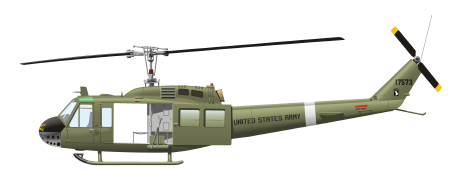 |
|
|
|
|
|
|
|
|
|
|
|
|
|
|
|
|
|
|
|
|
|
|
| |
Sp4 Joseph "Guy" LaPointe was a medic with Headquarters
Troop, 2nd Squadron, 17th Cavalry. On June 2, 1969, he was
just one day from going on leave to meet his wife and new son.
However, SP4 LaPointe volunteered for a mission that day because his
replacement was a new guy without any field experience. The patrol
landed on the top of Hill 376, near the famous "Hamburger Hill"
battle site. Sweeping away from the hilltop LZ, the point man walked
into a fire zone from concealed enemy bunkers. Two more men were
quickly wounded and "Doc" LaPointe moved forward to aid his wounded
buddies. He put himself between the enemy bunkers and the wounded,
and began working on the wounded. He was soon hit by enemy fire, but
ignoring his own wounds he continued to shield his buddies while
tending their wounds. He was hit by a second burst of fire and
knocked away from his friends. He crawled back to the wounded again
and once more shielded them from enemy fire while resuming his aid.
This time an enemy grenade landed among the group, mortally wounding
them all, including Doc LaPointe. He was awarded the Medal of Honor
posthumously on December 16, 1971. B
Troop, 2nd Squadron, 17th Cavalry Huey UH-1H that carried SP4
LaPointe on his last mission. Aircraft number was "17573". The 101st
Airborne Division emblem was displayed below the a/c number on the
tail. B Troop Hueys carried a white vertical tail boom stripe just
forward of the horizontal tailplane. Yellow crossed sabres adorned
the nose of the aircraft. The front ends of the skids were painted
black. The aircraft was commanded by Lt. Fernando DePierris. Lt.
DePierris flew numerous resupply missions through bad weather and
heavy enemy fire to the surviving patrol members trapped on the
hilltop. He lifted the survivors and casualties off the hilltop the
next day after the enemy positions had been taken out. This
Huey was turned over to the South Vietnamese when the 101st withdrew
from Vietnam. Surprisingly, the aircraft survived and is now on
display, complete with 101st markings, in the Vietnam War museum in
Ho Chi Minh City (Saigon). |
|
| |
|
|
|
|
|
|
|
|
|
|
|
|
|
|
|
|
|
|
| |
|
 |
|
CW3 Michael Novosel - October 2, 1969
82nd
Medical Detachment (Air Ambulance) |
|
|
|
|
|
|
|
|
|
|
|
|
|
|
|
|
|
|
|
|
|
|
|
|
|
|
|
| |
|
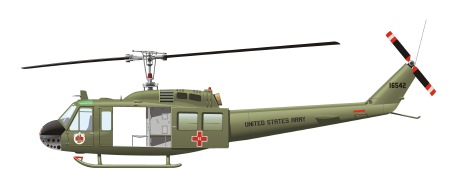 |
|
|
|
|
|
|
|
|
|
|
|
|
|
|
|
|
|
|
|
|
|
|
|
|
|
| |
CW3 Michael Novosel was pilot-in-command of of a UH-1H
med evac Huey with the 82nd Medical Detachment in 1969. On October 2, he
went to the assistance of a group of wounded South Vietnamese soldiers that
were pinned down by an enemy force concealed in a series of bunkers. Flying without any
gunship cover, he made repeated runs against heavy enemy fire to pick up
the wounded. Near the end of the action, he spotted a wounded ARVN soldier
near an enemy bunker. He maneuvered the ship near the wounded man and a
crewman reached down to grab and lift the wounded soldier into the aircraft.
During the maneuver the aircraft was hit by enemy fire and CW3 Novosel was
wounded. In all, Michael Novosel and his crew made 15 extractions in the
face of enemy fire, saving 29 wounded South Vietnamese soldiers. He was
awarded the Medal of Honor in 1971.
(Michael Novosel was a veteran of three wars - World War II, Korea, and
Vietnam. He flew B-29s in WWII and left the Air Force in 1953 as a
Lieutenant Colonel. He joined the Army in 1963 as a Chief Warrant Officer at
the age of 42. He flew over 2,500 med evac missions during two tours in
Vietnam.) 82nd Medical Detachment
aircraft had two distinctive insignia. They had a unique pilot's door
insignia involving a med evac kangaroo carrying a wounded youngster in its
pouch, over a red cross emblem. The nose and cargo doors also carried a
unique red cross, trimmed in white, without the normal white square
background. The unit designation "82" was placed in the center of the cross.
82nd Hueys had red tips on the skids. The call sign of CW3 Novosel's ship was
"Dust-Off 88". |
|
| |
|
|
|
|
|
|
|
|
|
|
|
|
|
|
|
|
|
|
| |
|
|
|
|
|
More Medal of Honor Hueys coming! |
|
|
|
|
|
|
| |
|
|
|
|
|
|
|
|
|
|
|
|
|
|
|
|
|
|
| |
|
|
 |
|
 |
|
 |
|
| |
|
|
|
|
|
|
|
|
|
|
|
|
|
|
|
|
|
|